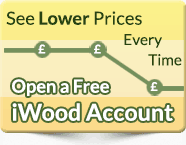External Cladding : Our Charred Cladding FAQ
Burnt Back Cladding is one of our newest products, so we are getting more and more questions about this cladding and why you should use it.
What species does the cladding come in?
As standard, we use British Larch for charred cladding, because it is the most cost effective of the timbers we supply. If you would like any other species, then please let us know and we’ll get a price for you.
What kind of charred cladding do you offer?
We offer this kind of cladding in tongue and groove, shiplap, rainscreen and feather edge profiles. On the website we only offer a few of the available profiles, if you want anything other than profiles on offer let us know and we’ll work out a price for you.
What’s the difference between brushed and unbrushed cladding?
Unbrushed cladding is rough to the touch and will still have loose soot on the surface of the board. However, brushing it smooths the surface and removes the excess soot. This can make the charring look slightly lighter in places.
Do I need to treat my Charred Cladding?
We recommend treating your cladding with Danish Oil every year. Although the cladding is pre-oiled weathering will eventually take the timber back to its original colour. The oil will also seal the wood to help prevent moisture movement.
What are the lead times on Burnt Cladding?
Because each board is hand charred with a blow torch the lead times are slightly longer than usual. Currently our lead time is 4-5 weeks.
Can I char my own cladding?
Yes you can, but please over order because your cladding will shrink so you will need more boards to match your coverage. Also having a few spares will come in handy just in case you accidentally overdo it on some of the boards.







 Main Menu
Main Menu

